
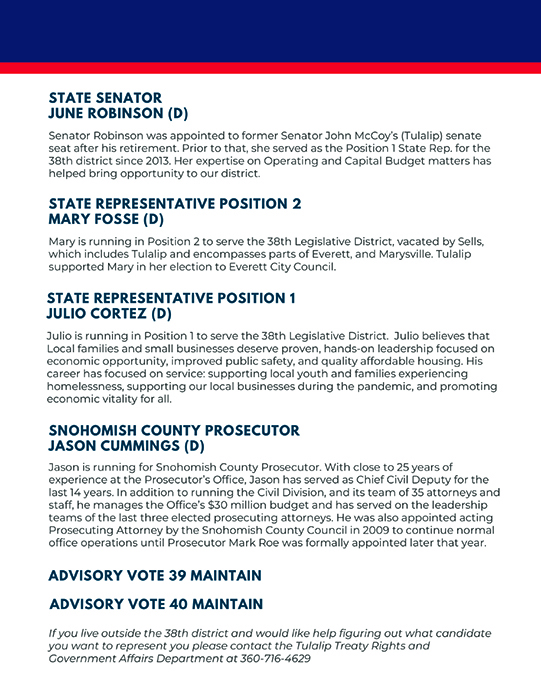
syəcəb
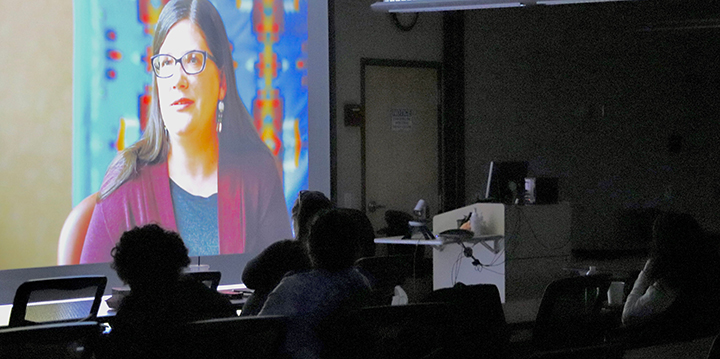
By Kalvin Valdillez, Tulalip News
The lights in room 162 of the Tulalip Administration Building were switched off on the evening of September 20. All eyes were watching a large projection screen at the front of the conference room as a movie was cast from the Panasonic overhead projector. There were over twenty ladies seated throughout the room. And although only visible by silhouette, they could not hold back some of the emotions brought on by the film, and were seen wiping tears from their eyes, shaking their heads in astonishment, and audibly gasping in shock as six Indigenous women shared their story in an 84-minute documentary titled, Sisters Rising.
The 2020 film is a moving, heartbreaking, and empowering watch that details the abuse and domestic violence (DV) that Native women face in today’s society. The film exposed the frustrating roadblock that those individuals experienced when they attempted to report the crimes committed against them and their loved ones.
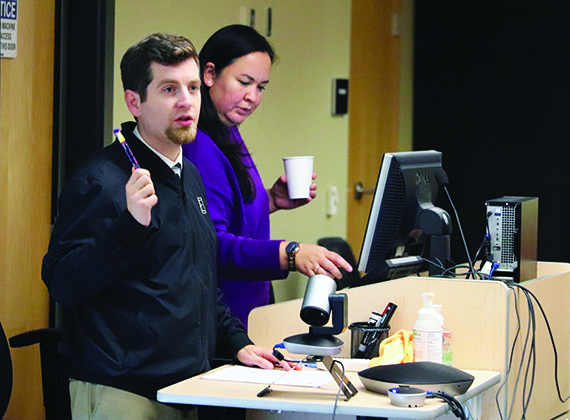
A Supreme Court ruling in the late ‘70’s ruled that tribal courts do not have the jurisdiction to try and prosecute non-tribal members who commit crimes against their membership. For decades, non-Natives targeted Native women, children and men on reservations throughout the country and got away with child abuse, sexual abuse, DV and much more, resulting from that ruling.
The women featured in Sisters Rising retold their stories and showed how survived those horrific experiences of abuse and DV. More importantly, it showcased their resilience as each of the six women went on to help their communities, whether through prevention and awareness work or taking the initiative to change legislation in their respective homelands. All of the women are making a big impact in their tribal communities.
The film’s synopsis leads with some eye-opening statistics: “Sisters Rising is a powerful feature documentary about six Native American women reclaiming personal & tribal sovereignty. Native American women are 2.5 times more likely to experience sexual assault than all other American women. 1 in 3 Native women report having been raped during her lifetime and 86% of the offenses are committed by non-Native men. These perpetrators exploit gaps in tribal jurisdictional authority and target Native women as ‘safe victims’. Their stories shine an unflinching light on righting injustice on both an individual and systemic level.”
Following the film screening, Tulalip Prosecutor Brian Kilgore was on-hand for a quick Q&A and to talk about how the film relates to the Tulalip Court and community. He shared, “The Supreme Court took away the jurisdiction of tribes to prosecute non-Indians. In 2013 we got back the ability to prosecute domestic violence crimes with Indian victims, with a couple of exceptions. One of those exceptions was there had to be a tie to this reservation. If you had people that were just passing through, we didn’t have jurisdiction. In October of this year, it was expanded again. Now we have jurisdiction over everybody.”
He continued, “This year I have gotten a felony DV referral every week, on average. It’s a lot. The other overlay here is that it’s not just jurisdiction over people. Tribes until very recently didn’t have any jurisdiction, we could only charge the not serious stuff. And what often happened is that the serious stuff got charged as not serious stuff. So, there might have been felony conduct but they still got a misdemeanor. Felony is anything greater than a year, misdemeanor is up to a year. The Tulalip Tribes had felony jurisdiction since 2012. We had two felony cases in 2015, and we had 70 this last year. It’s increasing; it’s not a good thing, right? But my sense is that there isn’t more crime, we’re just catching more of it, and we’re able to prosecute more of it. I think it is a good thing. I think the numbers we’re seeing are more realistic, and it doesn’t really represent more violence.”
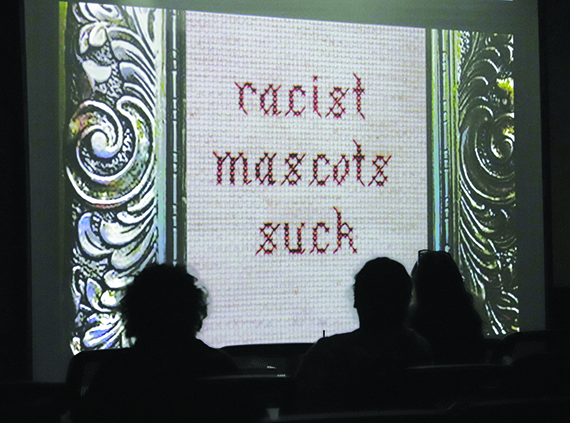
The film screening was hosted by the Tulalip Legacy of Healing (LOH) and the Child Advocacy Center (CAC) in observance of National DV Awareness Month. Throughout October, the two programs have held a number of events to help bring attention to the DV that occurs within Native America and more specifically, here at Tulalip. In addition to the Sisters Rising screening, they have also hosted a Resolving Trauma workshop with the Director/Consultant of the Midwest Trauma Services Network, Frank Grijalva MSCC, MSPH, as well as a self-defense class led by the Tulalip Police Department.
“One of the core focuses with DV Awareness Month is the importance of breaking the silence,” expressed Sydney Gilbert, CAC/LOH Coordinator and Forensic Interviewer. “If people are not talking about and it’s not coming to light, it lives in the shadow. The more we can talk about it, the more we can bring it to attention, the more we can normalize the conversation around it. We know that there’s higher rates of intimate partner violence in communities that have experienced trauma. Another focus we have for this month is addressing that trauma, and not only bringing attention to intimate partner violence, but bringing attention on how we can heal from that as a community.”
After the documentary’s credits finished rolling, Tulalip tribal member Lena Hammons, who sat attentively in the front row, expressed, “I loved that they were in front of tribal council proposing new codes to protect their women. I think that we need more people doing that, and if not go to General Council because it is a serious issue. I didn’t know there was 70 cases already this year and I’m out in the community a lot so that was kind of scary for me. I love the strong women who were standing up, helping each other and helping themselves. I’m a DV survivor myself, and had to fight for myself and my kids. It was nice to see they weren’t presenting themselves as victims, they were presenting themselves as survivors and supporters. Women need to know that they’re not alone and we need to support each other. Whether you know someone or not, if you know something is happening you need to report it.
“And for men and our women who are violators, it’s important for them to know that it won’t be tolerated. It’s not our way. It’s not traditional. It’s not cultural. It’s colonized behavior. It’s important for everybody to know that. You don’t have to tolerate DV. If you’re a perpetrator of DV, there’s help for you. Go get the help. Because we love everybody, and we don’t give up on anybody.”
If you or anybody you know is experiencing an abusive relationship, please do not hesitate to call the LOH at (360) 716-4100 for assistance. And if you are in a crisis or an emergency situation, the LOH provided a list of three additional hotline numbers that you can utilize during your time of need:
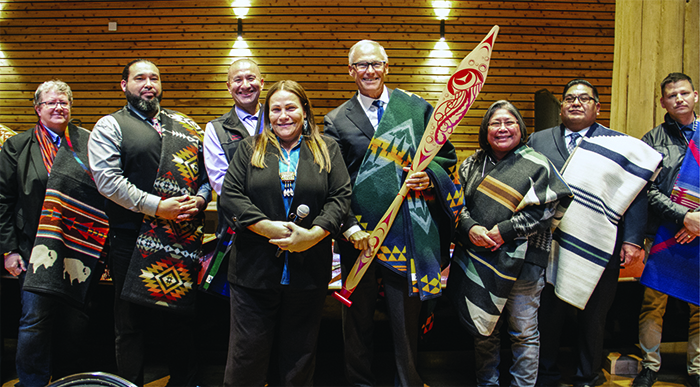
By Shaelyn Smead, Tulalip News
On October 24-25, Tulalip Tribes hosted the 33rd annual Centennial Accord at the Tulalip Resort Casino and the Tulalip Gathering Hall. Washington Tribal leaders, State legislators, Governor Jay Inslee, and numerous government agencies were in attendance to discuss policies and issues regarding tribal sovereignty, humanitarian efforts, and other tribal concerns.
The Centennial Accord was developed in 1989 by the federally recognized Indian tribes of Washington State and the State of Washington to build trust and confidence among the parties in the government-to-government relationship. Meetings like the Accord help strengthen the foundation for the future of tribes in Washington and how our people operate. Having a Native voice to discuss, change, and implement state policies significantly affects how Washington handles Native issues in the future.
Chairwoman Teri Gobin began the meeting by saying, “Thank everyone for all your efforts and being here today. My dad Stan Jones was a part of history and participated when the first Centennial Accord was passed. I remember praying that we would reach a point where our people would be treated as equals, our rights would be respected, and our sovereignty would be protected. Years of hard work have gone into this, and we are at a pivotal point in history where so many issues require us to take action now. Our ancestors are here with us and watching over us as we make these changes.”
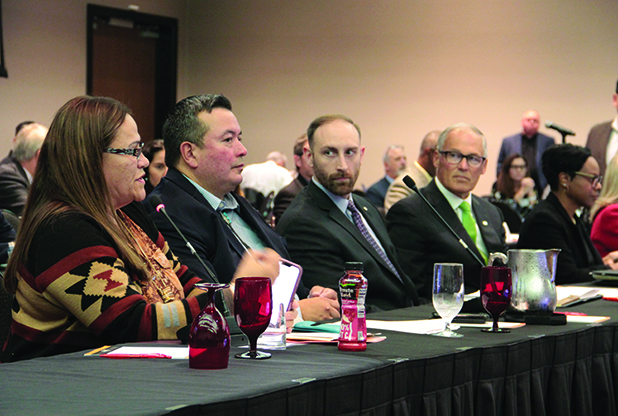
Throughout the day, the parties discussed specific issues involving education, health, the Climate Commitment Act, the HEAL Act, environmental justice, Social Services, and Natural Resources. The first day of the Accord is used to finalize details and answer concerns before presenting these agendas to the state Governor on the second day.
This year’s Centennial Accord was the first gathering that Higher Education acquired its own roundtable discussion. One of the many topics discussed was the lack of Native employee and counselor representation within colleges, funding towards Native students, and hardships that first-generation Native college students face. And though many of the public colleges are willing and able to work with tribes, establishing the foundation of these efforts is what many tribal leaders are trying to develop.
Representative Debra Lekanoff, D-Bow, was in attendance for the Accord and spoke about the actions that she is taking for Higher Education, “I’m proposing a Bill this year that provides free tuition, housing, and a stipend for food. This will apply to Native Americans of all federally recognized tribes across the nation attending (public) universities and colleges in Washington. If you are a Native from a federally recognized tribe from Montana and enroll in a university or college in Washington, then you can receive funding.”
During the Social Services meeting conversation focused on the Indian Child Welfare Act (ICWA) and the possibility of it being overturned by the Supreme Court on November 9. Ross Hunter, Secretary of the Department of Children, Youth, and Families, and Honorable Loni Greninger, Vice-Chair of the Jamestown S’Klallam Tribe, assured that they are working to prepare an argument for November 9 to preserve ICWA, and have been diligently working with other states in the US to do the same.
When speaking about the health struggles that Native people face, a State of Emergency was discussed, as Native Americans accounted for 63% of the suicide attempts in Washington in 2020. It was also noted that in 2001 the Native American mortality rate increased by 58%. To help mitigate this issue, the Substance Abuse and Mental Health Services Administration (SAMHSA) set up a 24/7 emergency hotline dedicated to mental health crises called the 988 Suicide and Crisis Lifeline. When a Native is suffering a mental health crisis, they can dial 988, explain that they are Native, and be transferred to a Native mental health and substance use disorder professional in their territory and seek specific cultural and spiritual guidance. It is a new program that SAMHSA hopes to have operational soon.
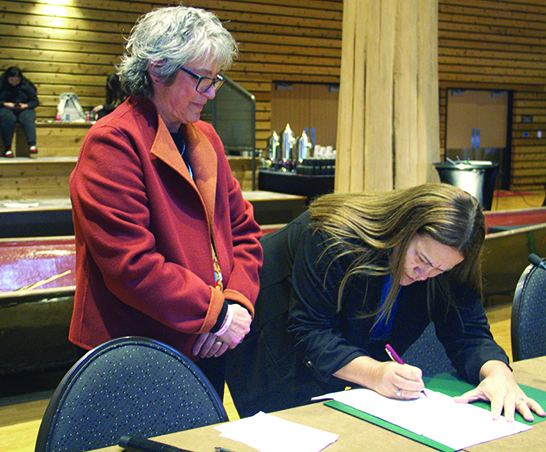
The opioid crisis was also heavily discussed at the Accord. Lummi Chairman William Jones Sr was transparent about their declaration of emergency, their struggles, and concerns about fentanyl, saying, “We keep talking about how it’s a crisis, and how devastating it is for our people, but why isn’t the government attacking this issue like they did Covid? I’m sure everyone in this room can say they have been affected by fentanyl. We’re becoming almost numb to hearing about overdoses, but we must figure out a solution and need real help from the state.”
Many other tribes shared their problems with fentanyl and how the lack of law enforcement and healthcare on reservations only continues to play into the crisis. The Chair of the American Indian Health Commission, Steve Kutz, responded by saying there is a need for a summit dedicated towards fentanyl, to which Governor Inslee agreed.
Another concern for many tribes is the Salmon crisis. Some tribes explained a severe decline in the salmon population in their area and an urge for government involvement and funding towards rehabilitation.
Senior Policy Advisor for Natural Resources for Washington, Ruth Musgrave, responded, “Although the Lorraine Loomis Act was not successful, this process is still ongoing, the two provisos were put into place. One was finding all the voluntary and regulatory programs agencies have for riparian restoration and protection. The other was to interview many of you [tribal leaders] and stakeholders about what would work for riparian restoration.”
She continued to speak on the 3.2 billion dollars that have been used towards salmon recovery, the Lower Snake River Dam initiative, erecting fish passage barriers, seeking tribal consultation, and the various ways departments continue to work together to try and institute change.
A historical moment occurred at the Accord as the Tulalip Tribes and the Department of Corrections held an additional signing ceremony for Senate Bill 5694, which Governor Inslee initially signed in March. The Bill recognizes tribes’ sovereign nations, equitable with any other state, state agency, county, or federal jurisdiction in decisions regarding the Department of Corrections. It also authorizes the Washington State Department of Corrections to negotiate agreements with Washington tribes to allow tribal court inmates to serve their felony sentences in an appropriate facility with access to Native rehabilitative services.
Throughout American history, our ancestors have struggled to protect our culture and way of life. With so many adversaries, the Accord continues to hold a place where tribal leaders get direct face time with Washington legislation, the state Governor, and government department leads. And though discussions can sometimes get heated, Governor Inslee stated, “Native Americans have a voice, and it is powerful.”
The state and tribes continue to work together, hold meaningful dialogue, and fight for our peoples’ voices and generations to come.
Please use the following link to download the October 22, 2022 issue of the syəcəb
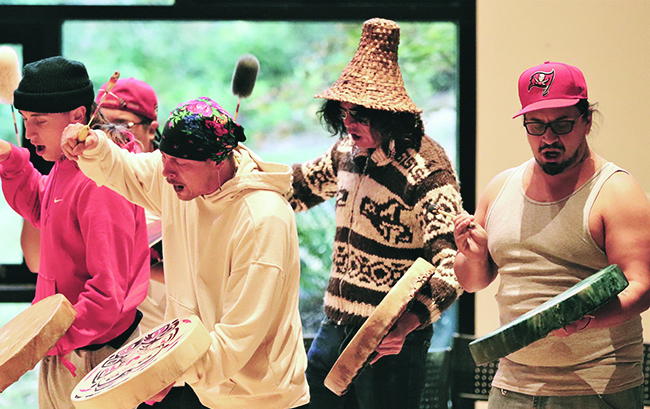
By Micheal Rios, Tulalip News
On October 14, the University of Washington hosted a Tulalip-led coastal jam as part of it’s back to school celebration. The mission was to empower the university’s Native American student population, while embracing the rich culture and traditions of local Coast Salish tribes.
Tulalip tribal member Chenoa Henry, former manager of the Grants and Self-Governance department, was announced as the new director of UW’s wǝɫǝbʔaltxʷ Intellectual House back in August. The 30-year-old husky alum wasted no time in coordinating the campus-based longhouse’s first ever coastal jam.
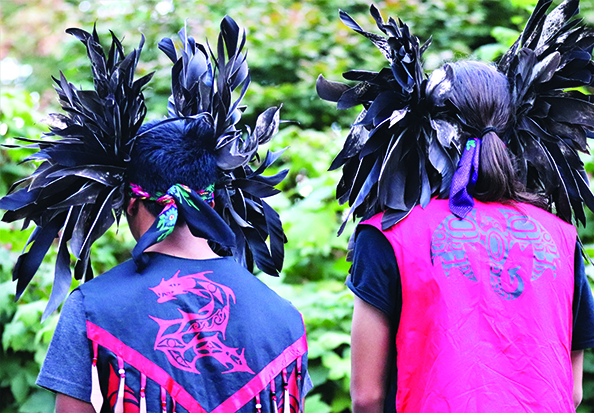
“After an inspiration lunch with Puyallup tribal member Danica Miller, where we pondered different ways to bring music, drumming, singing and all that kind of life and medicine into this UW longhouse space, a coastal jam just made sense,” said Chenoa, wǝɫǝbʔaltxʷ director. “I started the planning phase by reaching out to my cousins Thomas and Cary Michael Williams. They helped me out so much during this entire process by announcing and posting about the jam at other gatherings. The turnout was better than I could’ve imagined.”
The Intellectual House is a longhouse-style facility on the UW Seattle campus. It provides a multi-service learning and gathering space for Native students, faculty and staff, as well as others from various cultures and communities to come together in a welcoming environment to share knowledge. Its purpose came to life during the coastal jam as cohorts of tribal members from Tulalip, Lummi and Puyallup gave the longhouse a drum heartbeat and enchanting voice that rang out to anyone within earshot.

During the three-hour coastal jam, Native culture bearers from four different generations drummed, sang, and shared their culture to those who sat inside or stood outside looking onward in complete amazement. The seemingly endless supply of energy from the elementary and middle school aged Native dancers was contagious to the older generations who happily shared the floor.
“In bringing a coastal jam here to the UW, I’m healing my past version of myself who did not have access to such events or community as an undergrad,” shared Chenoa. “To witness our Native students and other minority students who showed up because they felt like they are a part of something, actually embracing our sense of community on campus, it just shows how much the university, it’s students and our culture has grown.
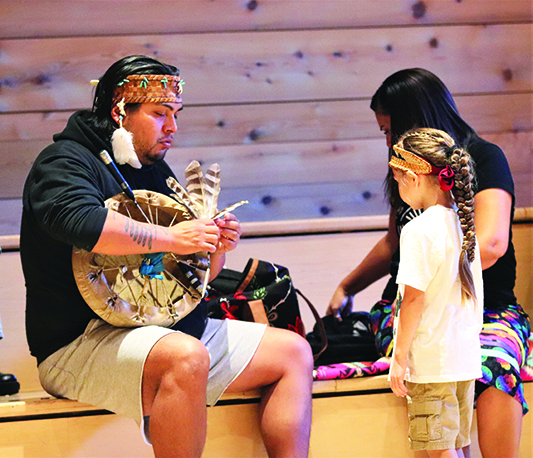
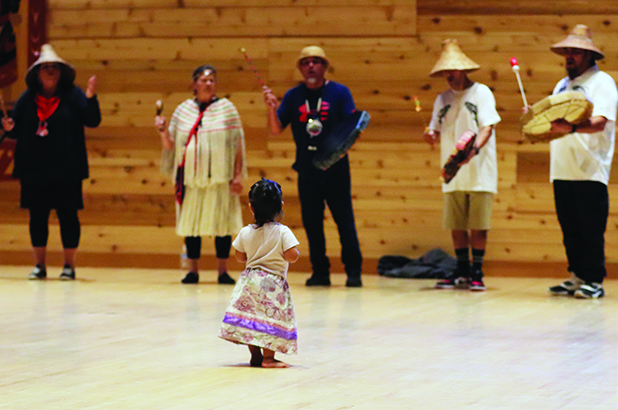
“For the future generations and all the young ones who helped express what it means to be Coast Salish, I want them to keep coming back and to know they belong here. I want that sense of belonging to be ingrained in them long before its time to apply for college.”
The University of Washington is estimated to have less than 1% Native student population, according to Data USA, yet with so many casino tribes in Washington State paying near full tuition rates for their tribal members seeking a college education, that number should be much higher. It’s the hope of student advocate Hailey Enick, First Nations @ UW co-chair and Tulalip tribal member, that hosting more culturally relevant events while being more welcoming to the original stewards of this land could cause UW to see a significant increase in its Native student admissions.
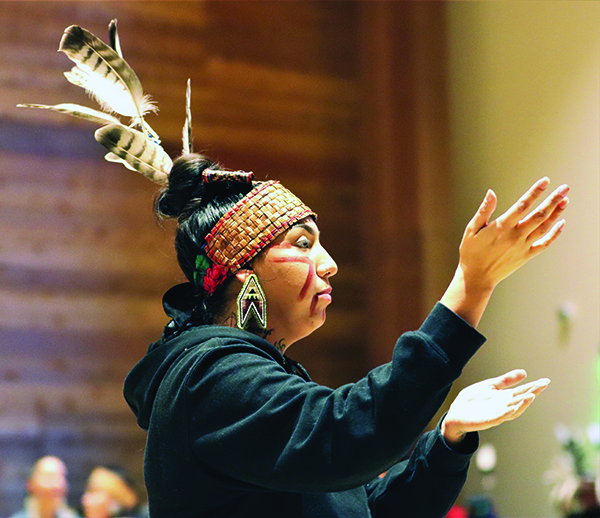
“To me the Intellectual House feels like a piece of home on campus. Hosting a coastal jam is only appropriate then with our mission to make our Native students feel comfortable and let them know our culture is celebrated,” explained Hailey, a fourth-year undergad student studying Education. “It was important we make this event coastal specific because we don’t have many events that are actually geared to our coastal traditions. We are on coastal lands, the traditional lands of Coast Salish people. Showcasing our space and traditions while building community with new students is how we bridge cultures and understanding.
“UW First Nations does host a big powwow every year and that’s cool, but these coastal songs are the sounds that I recognize, these are the sounds that I grew up with from home,” she added. “Powwow music is amazing in its own right, but it shouldn’t be synonymous with the tribes of this area. We have our own music, our own sounds and traditions.
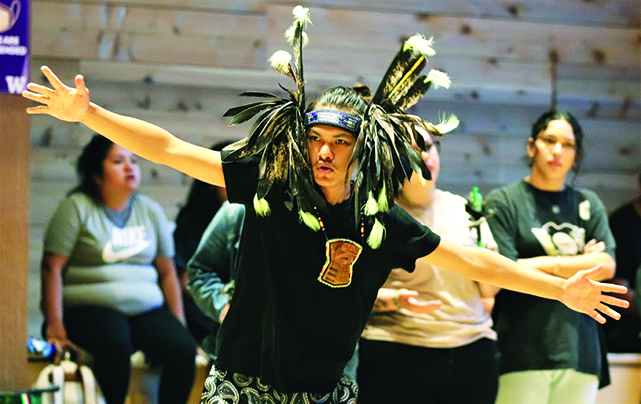
“My fellow students gaining insight to the beauty we have at home in Tulalip is amazing and healing and makes me feel comfortable to succeed as not just a UW student, but a proud Tulalip tribal member as well. It’s still early in the new academic year and I’m already so proud of the Native community we’ve built here. There is so much Native representation and culture on display every day. I’ve seen so many pairs of beaded earrings and vibrantly colored ribbons skirts already. I look forward to seeing many more in the future.”
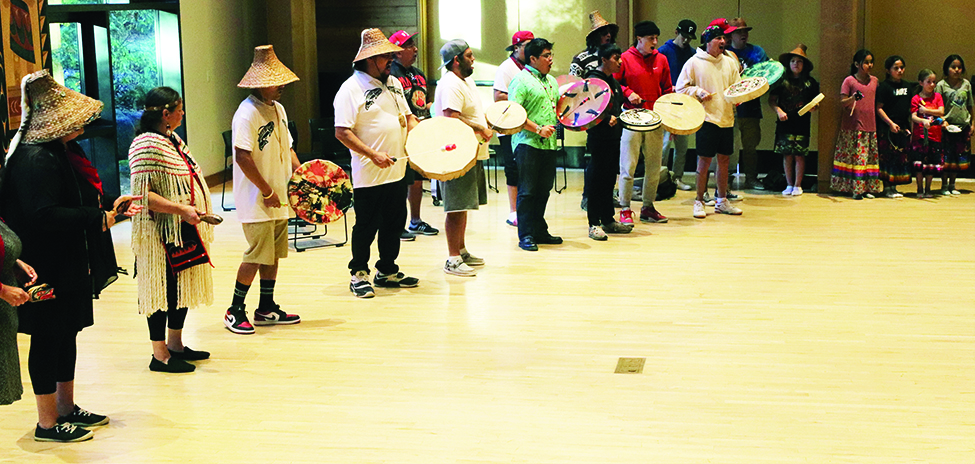
As successful as the evening of coastal culture on the UW campus was, it’s even more significant from the standpoint that two culturally grounded and college educated Tulalip women are implementing, in the real time, the changes that so many of the generations before could only dream of.

Submitted by AnneCherise Ramsey
People throughout the world value the Hawthorne plant as food and medicine for strengthening the heart and blood vessels. The Lushootseed word for the Hawthorne Plant is čibadac, and is a valued plant ally of the Coast Salish peoples. Čibadac has been used as traditional medicine in Indigenous communities for thousands of years. Hawthorne is best known as a cardiovascular tonic, easing pressure on the heart. It is a very safe plant to consume, with a wide variety of health benefits, aiding in easing instances of both physical and emotional stress. In this article, we will discuss the primary health benefits of Hawthorn, while also providing you with information needed to identify, forage, process and consume Hawthorn as a traditional Coast Salish food.
Identifying Hawthorne:
Hawthorne is a large shrub or deciduous tree with branches armored with large thorns. It is a part of the Rose family. Hawthorn trees can be small, ranging only a few feet tall, to up to 30-40 feet in size. Hawthorne is a native plant grown all around the Northern Hemisphere of the world, including America, Europe, Central Asia and even parts of Africa. There are over 280 species. The leaves are serrated, with medium to dark green colored leaves. In the Spring, Hawthornes leaves are soft and edible, with beautiful pinkish-white, fragrant floral blossoms. In the fall, the Hawthorn tree provides us with beautiful light-dark red Hawthorn Berries. The darker and brighter the berry, the richer it is in antioxidants. The flesh of the berries is edible, however the large seed inside is not.
When and How to Harvest:
Though the flowers, leaves and berries are all edible, in this article we will primarily focus on the Hawthorne Berries. Their prime foraging season starts in September and typically ends mid-November, all depending when the first frost hits. When scavenging for Hawthorn, look for trees with bright red clusters of berries. They are bright in color, ranging from a light red color to dark burgundy. These trees can be found along river beds, forests, meadows and ocean shores. In fact, there are currently a plethora of both large and small Hawthorn trees growing alongside the Tulalip Bay, with thousands of beautiful ripe Hawthorne Berries, eager to be discovered. The berries can easily be plucked, but be careful as the branches contain thorns. As you forage these beautiful berries, remember to only take what you need, giving thanks for its many blessings.
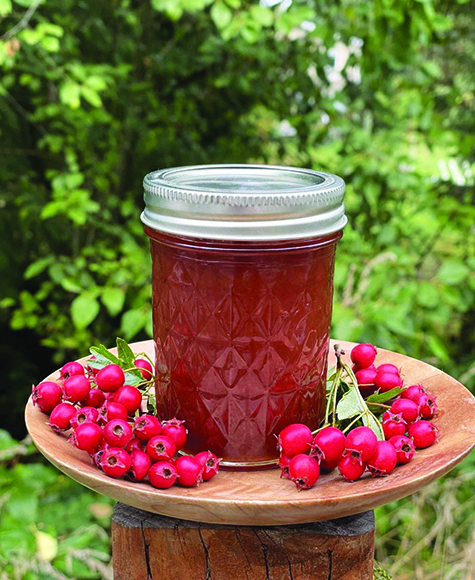
Hawthorne Food:
Hawthorn leaves and flowers can be added to salads in the springtime. In the fall, the leaves become stiffer and lose their palatability. The Hawthorn tree produces beautiful red edible berries come September. These berries taste semi-sweet, with a mild flavor, but contain a large seed that should not be consumed. Like cherry pits and apple seeds, the seeds contain cyclic acid, which should be avoided unless cooked or dried. Freshly picked, you can eat the outer flesh of the berry and spit out the seed.
Hawthorne Berries have an oily texture, and naturally contain pectin, a thickening agent used in making jams and jellies, making an excellent addition to any jelly recipe. Hawthorne Berries can be boiled in water and made into an extraction. They can also be dried and used into teas, or dried and ground into a powder. These are popular methods as Cyanic acid dissipates once the berries are cooked or dried. In the Hawthorne Honey recipe provided, we will be cooking the berries to create a Hawthorn Berry water extraction.
Hawthorne Nutrition / Medicine:
The heart is one of the most important, if not the most important organ in our body. It is continually pumping blood throughout our veins and arteries, delivering nutrients and removing waste products from trillions of cells. In traditional healing practices (Indigenous, Chinese, Ayurvedic, European), Hawthorne has been used as a plant ally to strengthen and open up the heart. It contains a wide variety of nutrients and antioxidants that make it a powerful medicinal food.
Hawthorne Berries are high in trace minerals such as selenium and chromium. Selenium is important for proper immune function, while chromium helps enhance the function of insulin – a hormone that helps regulate blood sugar levels (GoodGrub).
Hawthorn is packed with Antioxidants and Flavonoids: these are the plant compounds that help give food their color. The darker the berry, the more antioxidants and flavonoids are found. These compounds help support the overall vitality of the heart and cardiovascular system. They strengthen the blood vessels and help heal damaged vessel walls. “If it is used regularly, it can help balance both high and low blood pressure through increasing the heart’s ability to contract while gently relaxing outer blood vessels. Hawthorn also relaxes the smooth muscles of the coronary artery walls and allows more blood to flow into the cells of the heart. This means more oxygen and nutrients are delivered to heart cells and waste products are removed. It is therefore supportive for acute conditions like angina (chest pain). Hawthorn is also helpful in treating or preventing atherosclerosis (hardening of the arteries), which contributes to angina and heart attacks (GoodGrub)”.
Improved Circulation: Hawthorne is used to improve circulation, thus assisting in better brain health, mood and memory (Chevallier). Hawthorne should be consumed regularly to optimize its potential health benefits
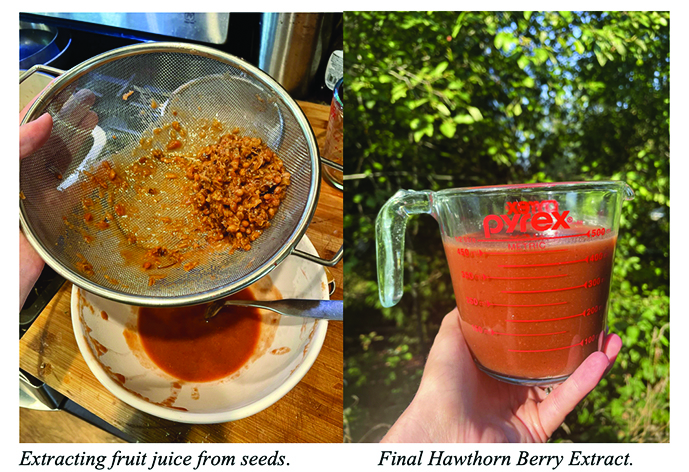
Hawthorn čibadac Extract & Hawthorn Honey
Ingredients:
Step 1: Forage Hawthorn Berries off of the Hawthorn Tree. See harvesting & identification instructions above. Be sure to properly identify berries from multiple sources before consuming wild foods.
Step 2: Remove berries from stem and leaves, leaving only the berries. Rinse and dry in warm water.
Stem 3: Boil berries in filtered water. Use a 1:1 ratio. For every 1 cup of berries, boil in 1 cup of water. Bring to a boil for 5-10 minutes, then reduce to low heat. Simmer for another 45 minus – hour, until the berries are soft. Berries should turn to a dull yellow/orange color from a bright red color.
Step 4: Once berries are soft, begin the mashing process by using a potato masher. Mash the berries to separate the edible portion of the berry from the seed. This process can take anywhere from 10-20 minutes depending on the quantity of berries cooked. Note, the berry portion of the berries are edible, but the seeds are not. The objective of the mashing process is to extract the edible berry fruit from the seeds.
Step 5 – Hawthorn Extract: Take mashed Hawthorne berries and run them through a fine-tuned strainer. Use a fork to mash out the maximum amount of juice from the seeds. This process takes time. Final product of hawthorn berry should look like a ketchup-like substance, it should naturally be a thick liquid due its naturally occurring amounts of pectin. From here, the hawthorn berry extract can be made into jams, jellies, soups, and in this recipe, added to honey.
Step 6 – Hawthorne Honey: Add 1/3 cup of Hawthorn extract to 2/3 cup of honey. Continue to add 1 Tbsp of Lemon juice for extra flavor and preservation. Stir Well. Store in the refrigerator. Use as an ingredient in your favorite teas for a healthy beverage sweetener.
Sources:
This institution is an equal opportunity provider. This material was funded by USDA’s Supplemental Nutrition Assistance Program – SNAP.
Persons with disabilities who require alternative means for communication or program information or reasonable accommodation, please contact Annie Ramsey at 360-716-5632 or ajensen@tulaliptribes-nsn.gov.
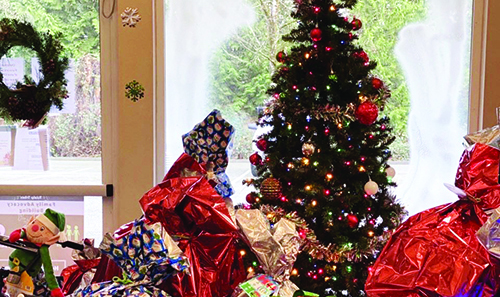
By Shaelyn Smead, photo courtesy of Tea Marquez
The beda?chelh department is looking for ‘Christmas Elves’ and sponsors to help fulfill the wants and needs of Tulalip’s foster care kids during the holiday season. People can get involved and impact the kid’s lives by changing their Christmas mornings.
Each kid receiving these gifts is a Tulalip tribal member and part of the placement home foster care system that beda?chelh has set in place. Currently, around 150 children between newborn and 18 are on the list to receive gifts, and only about 50% of the kids have received sponsorship so far. Beda?chelh hopes to fulfill every item on each child’s list and will continue accepting donations until they do.
Each child can add whatever they want to their list, giving sponsors context of what to shop for. With the encouragement of Placement Specialist Tea Marquez, she tells the kids to ‘aim high and shoot for the stars.’ The lists are also reviewed with their Placement Specialist to add any items they feel the child needs and edit any requests based on the safety and well-being of the child. Some lists include essential items like diapers, clothes, and gear for young babies. For a little older children, their lists could request toys, school supplies, or new shoes. And for a child about to age out of foster care and preparing for college, it could be items like a new laptop, cell phone, or tv. Every child’s needs are different, but the possibilities are endless with various donations and sponsorships.
Currently, beda?chelh is fortunate enough to maintain large donors like Nike, Under Armour, Tulalip Resort Casino, the Arlington Lifeway Church, and others. These donors help support some of the more costly and name-brand items on the kids’ lists. But as Tea said, they are looking for anyone to help sponsor at any dollar amount. Tea explained that every donation is appreciated, no matter how high or low.
Beyond reaching out to their re-occurring sponsors, beda?chelh is also looking for more Natives and sponsors within the community to get involved. “To know that your community is helping one another and supporting our youth that needs it, says a lot about the community. Some of these kids feel like their community has turned its back on them, and it would make such a difference knowing that tribal members are willing to step up and help them in these ways,” Tea said.
The department is also planning a Christmas Party for the kids to gather together, receive their gifts, and spend time on tribal land with other tribal children. Because of the confidentiality of the beda?chelh department, the party will not be open to the public. The party will still consist of plenty of cultural activities to maintain each child’s connection to the community and our people.
“The party is an added bonus for [foster] families. We know it’s hard for some of these kids to be away from their families or parents, and we know we can’t make up for that time. But we are doing our best, doing what we can to make sure they feel loved and supported and giving them a great holiday experience,” Tea explained.
In many ways, providing a holiday experience is one of the reasons that the beda?chelh department differs from state-sourced foster care systems. Beyond providing placement homes for the children, beda?chelh strives to keep tribal youth involved in cultural activities, engage with other tribal youth, and offer childhood experiences that every child should have.
“I’m excited to get our families engaged and have everyone interact with the other families and staff. I love that we can put a smile on their faces. We always try to stretch our funds to the max so we can make the most out of experiences like the Christmas party, the best. We want them to have the fun and exciting experiences that the holidays bring,” Tea explained.
Children who cannot attend the Christmas party or pick up their gifts will still be able to receive them in the mail.
Even when every sponsor spot is filled and the holiday season is over, beda?chelh will continue to accept donations. Anyone wanting to get involved can give a monetary donation or donate gifts like clothes, school supplies, toiletry items, and toys. Beda?chelh requires any donated physical items to be new, with tags, and unopened. Beda?chelh is also still looking for more respite care and placement home volunteers.
If you or someone you know would like to get involved or help donate to tribal youth, don’t hesitate to contact Tea Marquez at 360-716-4047 for the remaining list of children.
LOH and TPD team up to bring safety tactics to the community during DV Awareness Month
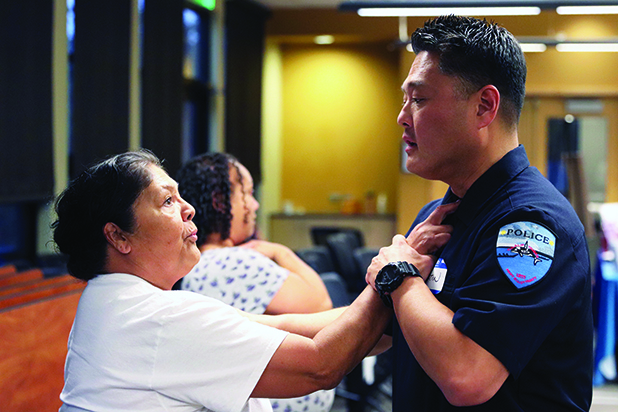
By Kalvin Valdillez, Tulalip News
“I feel confident now. A lot more confident,” reflected Tulalip tribal member, Carlotta Davis. “I feel like if somebody came at me, I’d be able to not freak out and apply what I learned in this class tonight. There’s a lot of weirdos out there. Even going to the grocery store, we have to be alert and be able to protect ourselves.”
Empowered is the word that best describes a group of ten ladies, all hailing from the Tulalip community, who attended the Legacy of Healing’s (LOH) self-defense class on the evening of October 13.
Over the past several years, the LOH has taken part in a national initiative known as Domestic Violence Awareness Month. Through this initiative, the program has brought attention to a problem that plagues Native communities across the nation, while also providing resources, support, information and help to Tulalip tribal members, other tribal members, as well as parents, guardians, and spouses of Tulalip members who are experiencing DV in the household.
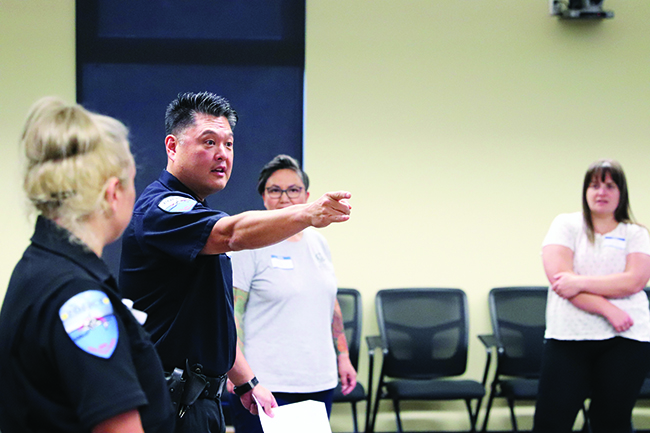
Through a 2016 study conducted by the National Institute of Justice, it is apparent that Indigenous women and men are faced with DV situations more than any other race or community in the U.S. The official statistic shows that 84% of Native women have experienced violence in their lifetime as well as 81% of Native men. That same study stated that more than four in five American Indian and Alaskan Native women and men experienced DV in 2016 alone.
To say that the LOH is active during DV Awareness Month is an understatement. During each week of October, the LOH team, along with the Child Advocacy Center (CAC) team, can be found out in the community, imparting knowledge to the people about what DV is and how it affects the home and community at large.
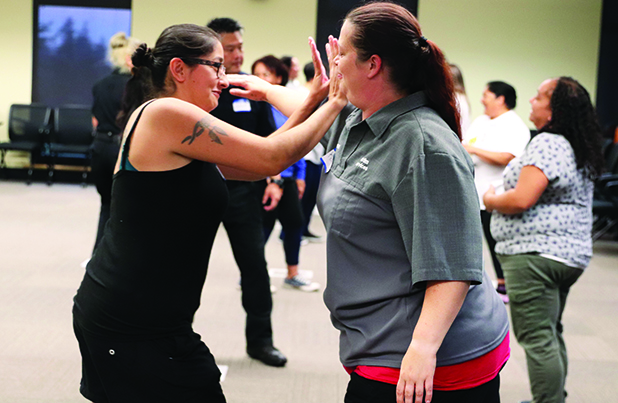
This year, LOH is hosting a total of four classes to raise awareness. The first event was an eye-opening and moving workshop dubbed Resolving Trauma that was taught by Director/Consultant of the Midwest Trauma Services Network, Frank Grijalva MSCC, MSPH. And to follow that event, LOH partnered with the Tulalip Police Department (TPD) for the first self-defense class at Tulalip since the pandemic hit.
“A few years ago, we put together some self-defense classes for one of our awareness months and there was a lot of interest from the community,” explained LOH and CAC Director, Jade Carela. “And so, the idea came up within our staff about doing another one. I reached out to TPD Chief of Police, Chris Sutter, to see what he thought about it. The chief is extremely supportive of our two departments and thought it was a great idea. This is so good for our community, and another way of promoting something within our community to teach them ways of protecting themselves.”
The hour-and-a-half class was led by TPD Officer Justin Lee, with assistance from Officer Cheyenne Bear and Detective James Cabras. After taking some time to stretch out, the group circled up in room 162 and were taught a variety of techniques including stances, breakaway and blocking maneuvers, as well as kicks, strikes, and punches. The class leaders also spoke about the importance of knowing the vulnerable areas of an attacker and carrying personal protection such as pepper spray, mace, and tasers.
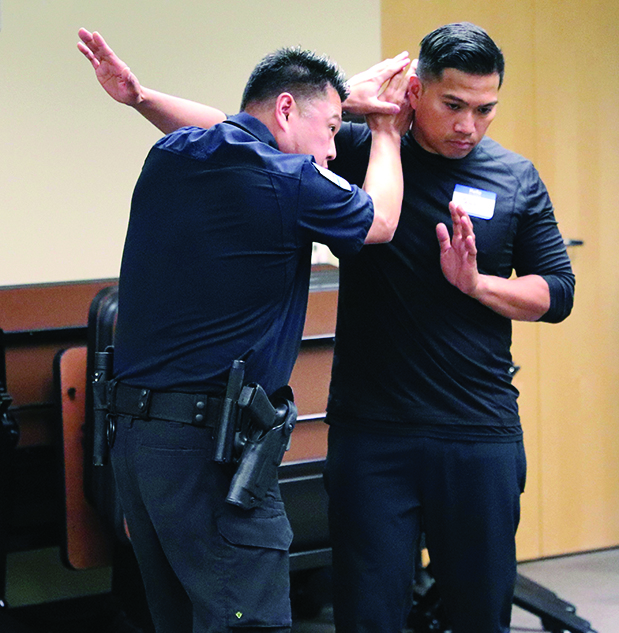
Although the attendees took the lesson very seriously, they still found time to share a few laughs together throughout the beginner’s course. The TPD officers showed the ladies each self-defense move at 20% speed, then they walked about the classroom and gave them the opportunity to correctly demonstrate the techniques back on them. Once the class got the moves down pat, they partnered up and tried their newly acquired skill on each other.
Said Officer Lee, “We all have been affected by domestic violence. We all have experienced it in one way or the other. So that’s why it’s important for us continue with this training and continue this awareness, so that we as a community can continue to better ourselves, empower ourselves, and not be victims anymore. Having the police department actually teach the class versus hiring a company, which they have done in the past, didn’t really work out, because I think the heart is not there. For us, we serve Tulalip, this is our community, this is our police department, this is our people. We want to empower our people, and we want to give them tools and also the confidence.”
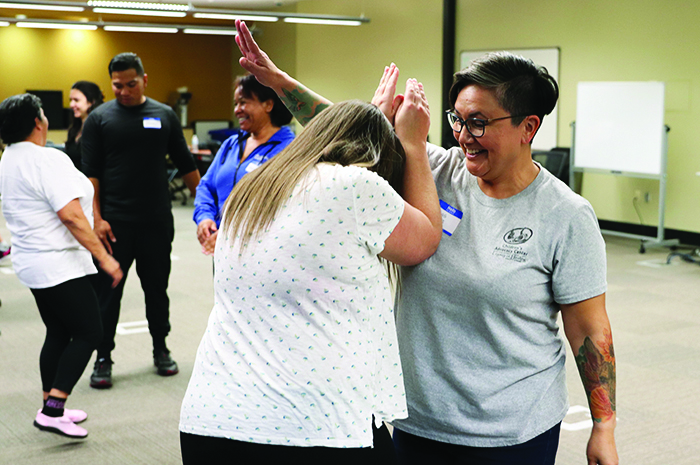
“It was an awesome turnout, everybody was really engaged,” added Detective Cabras. “I think the goal of this class was to empower the women of the community to take back their individuality and make connections with other people, and they received it well. We talked about the difference between self-defense and defensive tactics, we spoke on the difference between what law enforcement does as far as defensive tactics and what private citizens can do. We also equipped them with some tools to defend themselves when they’re faced with situations, and we talked about the mindset that they should have. We tried to focus on the fact that they’re no longer victims; they’re strong, independent women who can handle themselves if needed.”
Following the self-defense class, attendees were provided a sandwich-spread dinner and learned about the DV Awareness Month raffle. Prizes include a custom-designed hand drum, beaded earrings, tribal member artwork, Under Armor shoes, and much more. Raffle tickets can be purchased at any of the remaining DV Awareness month events or during their pop-ups at the ti kuphihali café at the Tulalip Admin building on Fridays between the hours of 12:00 p.m. and 2:00 p.m. Tickets are $5 each or five for $20.
“This event was extremely important,” Jade stated. “A lot of people, even people who don’t experience DV necessarily, were able to learn different ways of protecting themselves in safe ways, because we never know what is going to happen. You could be put in a dangerous situation at any second of your life. This class provided more tools to keep themselves safe.”
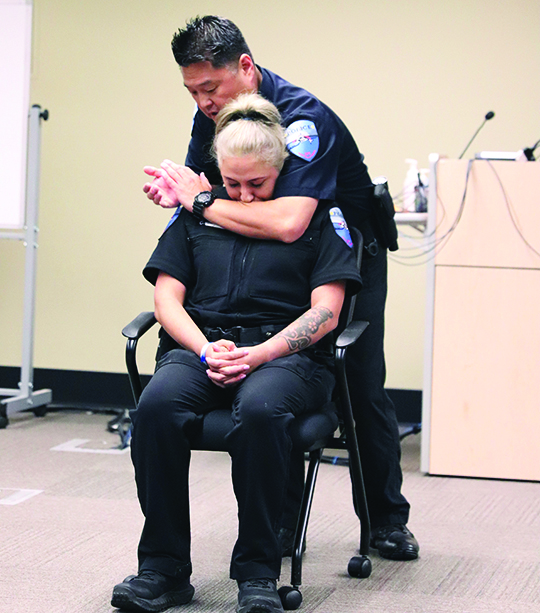
She continued, “I think it was important to have TPD teach the class because it gives the community the opportunity to see them in a different light. It helps them feel safer and learn from them in a different type of space and bond with them. I love seeing that interaction and it makes me so happy to know that we have community members coming together to support these activities. At the end of the day, it shows that we have people supporting our victims and survivors of DV.”
DV Awareness Month continues with the last two events held on Thursday October 20 and Tuesday October 25 respectively. The next event is a film screening of the Indigenous film, Sisters Rising, and the last event is a Beading as Healing class. Both events begin at 5:30 in room 162 of the Administration Building. And if you would like to show your support for DV victims and survivors, be sure to wear purple on October 25th.
If you or anybody you know is experiencing an abusive relationship, please do not hesitate to call the LOH at (360) 716-4100 for assistance. And if you are in a crisis or an emergency situation, the LOH provided a list of three additional hotline numbers that you can utilize during your time of need:
Please use the following link to download the October 15, 2022 issue of the syəcəb
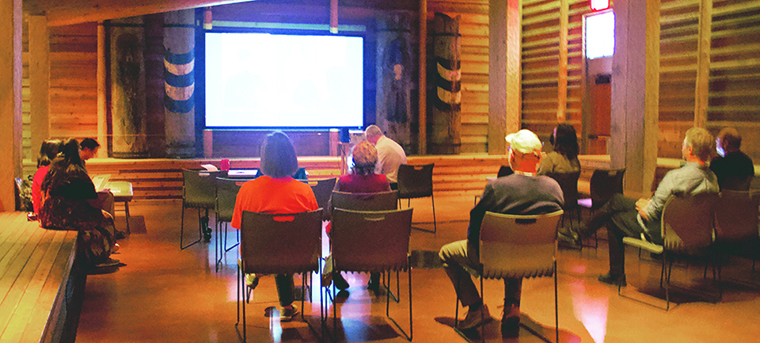
By Shaelyn Smead, Tulalip News
Filmmakers, creators, and artists gathered at the Hibulb Cultural Center on October 8 for the 10th Annual Film Festival. With nine Native and non-Native films, ranging from animation, music videos, drama, and documentaries, the festival delivered a diverse collection for all to enjoy.
Created in 2012 by Hibulb Cultural Center Education Curator Lena Jones, this year’s film festival theme was Healing Generation to Generation. It is a concept centered around generational healing and recognizing those that provide hope for the future.
Honoring the theme, a couple of standout films were ‘We Still Live Here’ by Anne Makepeace, which follows Wampanoag social worker Jessie Little Doe and her journey to reviving the lost language of her people, and ‘From Programs to Pilgrims’ by Simme Bobrosky. The film portrays Simme’s discovery of her Ukrainian roots and familial journey into America. She used old photos of her family and animated them to look alive as if they were speaking into the camera.
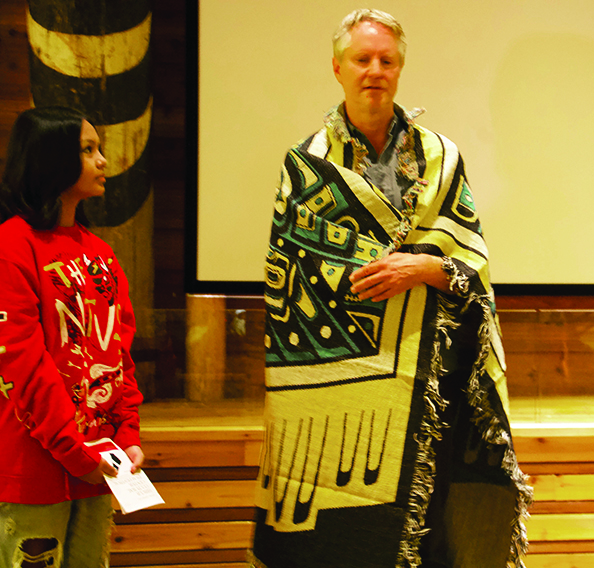
Two cinematographers were honored with the Lifetime Achievement Award, Robert Lundahl and Eero Johnson, during the event. Each award winner shared information about their works and the different inspirations they derived from.
Robert received recognition for his role in regional, cultural, and environmental sharing. His film “The Burden of Proof,” based on the use of Agent Orange in national forests, was used as a demonstration screening for a U.S. Senate subcommittee about the environment. He also created “Unconquering the Last Frontier,” which was filmed in Washington and based on the salmon crisis within the Pacific Northwest. It centered more specifically on the Elwha River and its removal.
Eero received recognition for Coast Salish cultural sharing and storytelling. Throughout his career, Eero has maintained a close connection to Indigenous people. He has worked closely with Tulalip Media and Marketing and worked for Northwest Indian News. He spent several years following the canoe journey and shared the many stories of canoe families. He produced many pieces centered around popular Native artists, painters, performers, and carvers. He also created films involving issues like Treaty Rights, the Boldt decision, and Residential Boarding Schools. His countless efforts to share the perspectives and stories of Native American people made him an ideal candidate for the theme and the Lifetime Achievement Award.
In his thank you speech, Eero said, “Twenty years ago, when I started working with Indigenous people, it was a turning point for me professionally and personally. It was a chance to visit a place I ordinarily wouldn’t have gone to, be involved in events I wouldn’t have known about, and meet some amazing people. One of my first stories was about the Cushman Boarding School, and it’s sad to say, but in my non-Native upbringing, I didn’t know any of the history until I found myself doing this work. This has been a journey of learning about pieces of history that deserve to be talked about.”
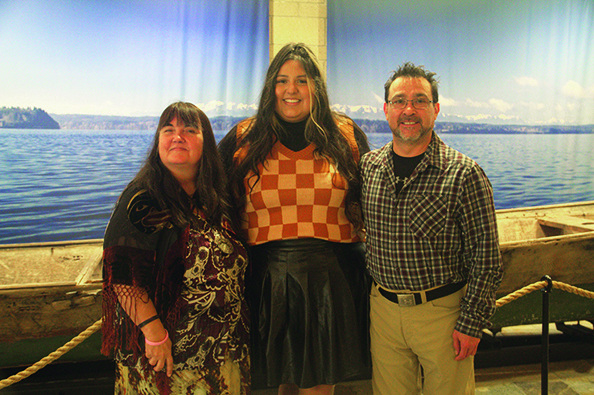
The Film Festival judges consisted of film advisor Antonia Ramos (Tulalip), filmmaker Mike Van Luvan, and Native radio Host/Producer Robin Carneen (Swinomish). Each submission to the film festival was reviewed by the judges and nominated for an award. The awards varied from best feature, best music composition, best acting male/female, best experimental, best directing, etc. Judges are asked to pay close attention to and judge based on script, creativity, coherence, meaningfulness, and editing.
In addition, a special emcee was introduced to this year’s festival, “This year, we were very fortunate to have Tulalip’s own Faith Iukes emcee our event. We’re very grateful there are youth willing to help make our film festival successful,” Lena said.
Hibulb staff encourages all filmmakers to participate in the film festival. If you or someone you know is looking to submit for the next film festival, please call the cultural center at (360) 716 – 2600.
2022 Film Festival submissions: